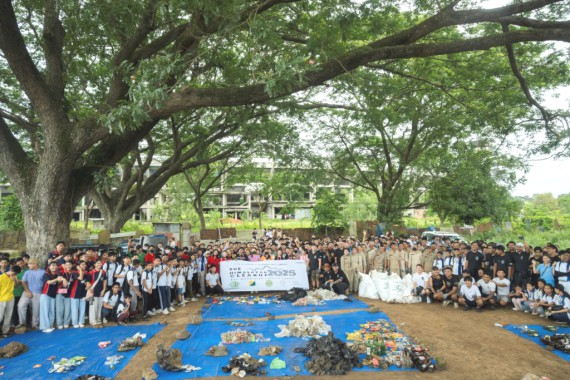




















Monday, Aug 11, 2025 23:15 [IST]
Last Update: Sunday, Aug 10, 2025 17:37 [IST]
GANGTOK, : PepsiCo, Coca-Cola, Kaisha Industries,
Natural Water Industries, Parle, Vinayaka Industries, Hornbill Industries, ITC,
CG Foods and Perfetti Van Melle were revealed as the top 10 polluters of the
Indian Himalayan Region for 2025 at the webinar “The Himalayan Cleanup Speaks:
Insights to Action” held on August 8, the Zero Waste Himalaya Day.
The top polluters were identified through The
Himalayan Cleanup (THC) audits conducted across eight mountain States, where
12,500 volunteers cleaned 148 sites and audited 217,854 pieces of plastic waste
collected.
“The Himalayan Cleanup 2025 has put the spotlight on
the Himalayan waste crisis and a call to action against plastic pollution. The
Himalayan Cleanup waste and brand audit insights becomes more pertinent at the
time of the global treaty negotiations to end plastic pollution. It highlights
the need to have a vulnerable areas approach to the plastic waste crisis while
adopting a complete life cycle perspective with producers taking responsibility
as well as intersecting it with food and nutrition security, climate and
biodiversity crisis,” states a Zero Waste Himalaya press release.
Zero Waste Himalaya and the Integrated Mountain
Initiative have been anchoring The Himalayan Cleanup since 2018, conducting
waste and brand audits to identify the companies polluting the Himalayas and
calling on them to take responsibility for their plastic waste, including
designing it out of the system altogether. The campaign also calls for the
effective implementation of Extended Producer Responsibility (EPR) rules with targeted
focus for the Himalaya that recognises the importance and fragility of the landscape,
the release adds.
The webinar’s context setting highlighted that
existing policies and practices are not sensitive and sufficient to respond to
the Himalayan waste crisis, and that there was a need to acknowledge the
socio-ecological importance, fragility and challenges of the Himalaya. The need
to shift the solution narrative beyond the broom, bin, landfill, burn and roll
it downhill and to towards systemic solutions was stressed.
The presentation on findings of THC 2025 by Priya
Shrestha, a member of Zero Waste Himalaya, highlighted that 217,854 plastic
waste collected was 93% of the total waste collected. The release states that 47%
of the plastic waste collected was non-recyclable, thus challenging recycling
as a complete solution. “There has been a dramatic reduction in the non-recyclable
plastic collected in THC2025 compared to the past six years that needs a deeper
trends analysis. 53% of plastic waste
collected was recyclable and shows that the mountains are struggling with
collecting and linking recyclable plastics for processing.”
Food packaging was consistently the highest trashed item
at 93% of all plastic waste, reflecting the continued trend of junk and
ultra-processed food consumption and the contribution of “Big Food” to the
Himalayan waste crisis.
“As many as 52% of food packaging audited was
non-recyclable which highlights the limitations of recycling as a solution.
47.5 % of the food packaging was beverage bottles and 11% of it was the energy
drink Sting, which had very high consumption among students, though it was not
labelled as not recommended for children, pregnant women and lactating
mothers.”
While ‘Sting’ continued to top the list, THC 2025 showed
an overall increase in the number of energy drinks. The intersection of food
and waste was described as particularly concerning for mountain communities,
with clear evidence linking ultra-processed food and beverages to rising
non-communicable diseases and contributing to mental health issues, the release
adds.
In addition to the top 10 polluters, brands such as Nimoj
Industries, Parshuram Packaged Drinking Water, Nestlé, Fresho Beverages, Linggi
Lehmo Beverages, Haldiram’s, Pran, Dabur, Mondelez, and Reliance were among the
top 20 companies polluting the Indian Himalayan Region according to THC 2025.
“While the top global and national brands have
continued their presence as top polluters, THC2025 showed a big jump of local
brands and bottled water brands that calls on targeted localised actions to reduce
their plastic pollution.”
RK Paul Chawang, Amyaa, Arunachal Pradesh; Shirshendu
S Das, Midway Journey, Assam; Kamlesh
Rai, Biruwa, Darjeeling/Kalimpong; Abdul Rashid Bhatt, Kashmir University, Jammu
& Kashmir; Preeti Chauhan, Little Green World, Leh Ladakh; Yoyung Shaiza,
Enfogal, Manipur; Subhashish Dasgupta, MIMDI, Meghalaya; Mery Chakma, Mizoram
Waste Solutions, Mizoram; Niksungla, Living for Environment, Nagaland; Tshering
Uden Bhutia, KCC, Sikkim, shared their key insights across the Indian Himalayan
Region anchoring the THC2025 in their respective States and regions.
“While there is a need to look at the Himalaya with
focussed urgency, contextual nuances across the IHR have to be factored in too
in response to the waste crisis. These reflections also committed to taking THC
insights as well as the Zero Waste Himalaya movement further into their states
and regions.”
Jigme Bhutia, MD, SBM, Sikkim, said that THC had
been instrumental in informing local waste management strategies and expressed
hope that the demand for EPR would lead to meaningful outcomes.
IMI president Ramesh Negi, in his closing remarks,
reiterated the Himalayan agenda and called for mountain-sensitive policies and
the allocation of adequate resources. He advocated for a development paradigm
in the Himalaya that is neither extractive nor polluting and congratulated the
organizers and volunteers of THC for their stewardship.